Foreign Insulators
by Marilyn Albers
Reprinted from "Crown Jewels of the Wire", July 1991, page 6
HERMSDORF - A GIANT AMONG EUROPEAN
PORCELAIN INSULATOR WORKS
Back in the late 1880's there was a joint stock company known as KERMISCHE
WERK KAHLA, or the KAHLA PORCELAIN WORKS, with headquarters in Hermsdorf,
Thuringen, East Germany. Its other factories were located in the towns of Gera,
Kahla, and Sonneberg, all within a few miles of Hermsdorf. At least one of these
plants produced high frequency ceramics for radio purposes, and it is believed
that the one in Sonneberg (which went by the name of KOPPELSDORF) manufactured
porcelain insulators because several pintypes have been found with their
trademark (below).

KAHLA PORCELAIN WORKS established still another branch company in Hermsdorf,
which began production on January 6, 1890, with just ten raking ovens. For the
first two years, until 1992, the Hermsdorf plant manufactured only dinnerware.
The factory was in a favorable business location, having been built on the water
shed between two important water routes -- the Saale and the Elster Rivers. This
was also conveniently near a plentiful supply of wood, which was essential as
fuel, and labor was cheap in this poor woodland area.
The establishment of the HERMSDORF FACTORY came at a time when
electrotechnology was undergoing a surge of rapid development. Thus, in 1889,
the three-phase current motor was invented by M.O. DOLlWODOBROWOLSKI, in 1890,
the first oil transformer was built by C.E.L. BROWN, and in 1891, the first
three-phase current power transfer from Lauffen to Frankfurt on the Main
followed with 15,000 volts. In the year 1892, the metal filament lamp was
invented by K. AVER VON WELSBACH. All this progress led to a new epoch in the
history of electrification, and the new transfer techniques with three-phase
current proved to be a powerful impetus. With the tremendous increase in the
demand for porcelain telegraph insulators, the HERMSDORF PORCELAIN FACTORY
quickly prepared itself to meet this challenge. By the summer of 1892, it had
succeeded in a complete change in production to that of electroporcelain.
There was a problem, however. Insulators, which up to this time had been used
successfully for the transfer of energy, now were found to be inadequate for
meeting the electrical demands placed upon them. So the research department at
HERMSDORF got down to business in a hurry!
At about the same time, 1896-1897, fundamentally new forms of high voltage
insulators appeared in the PADERNO BELL in Italy (see reference to this in
"Foreign Insulators" column, April, 1990, issue of Crown Jewels of the
Wire) and the DELTA BELL in Germany. The DELTA BELL especially represented a
milestone in the evolution of these high potential insulators. It was developed
in 1897 by Professor ROBERT M. FRIESE together with the HERMSDORF PORCELAIN
FACTORY, protected by both domestic and foreign patents and further developed in
field testing at HERMSDORF in the following years.
The name "DELTA" BELL comes from the triangular shape of the outer extended shell or skirt, which resembles the Greek letter DELTA
for "D". This design controls the side discharge of electrically
charged water particles. Take a look at the development path of the DELTA BELL
through the years and notice the gradual transition from a delta to a tri-delta
insulator, which is the technical and historical origin, of the HERMSDORF
trademark.
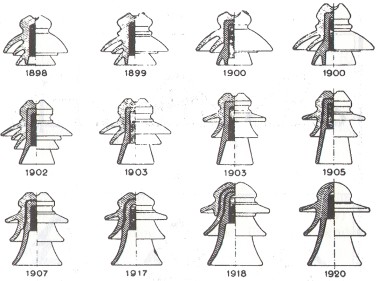
Development of the DELTA BELL
In relation to HERMSDORF'S trademarks, it is interesting to note how these at
first reflected the actual technical development of their insulators, but eventually had more and more of a highly imaginative conceptual relation to
the real product. After only a monogram in baroque lettering (1903 - HP for
HERMSDORF PORCELAIN) and a naturalistic representation of a pretty average
looking insulator with the initials H.-KL. (1903 - for HERMSDORF-KLOSTERLAUSNITZ,
the name of their railway station), which were used initially, the next
trademark showed the DELTA BELL insulator with the word "DELTA"
(1910). Between 1913 and 1920, this was followed by stylized representations of
the large Greek letter Delta used with the letter "H" for HERMSDORF.
In 1922, through a. merger of capital from several electroporcelain operations,
the so-called HESCHO, with headquarters in HERMSDORF, was formed, which in 1923
resulted in the development of the tri-delta sign still in use today. That
sequence of events was that the company called H. SCHOMBURG & SONS entered
into a "interest union contract" with the KAHLA joint Stock company. This resulted in the formation of a sales
organization called HERMSDORF-SCHOMBURG INSULATORS, which came to be
known simply as HESCHO. Insulators have been found marked with the word HESCHO
or with the tri-delta trademark. Other participating factories in this group
were those of MARGARETHENHUTTE and FREIBERS, both of which were located in the
state of Saxony, rather than in Thuringen as were HERMSDORF and H. SCHOMBURG
& SONS. In 1954, the letters KWH were added to the trademark for the now
nationally owned company "KERAMISCHE WERKE HERMSDORF", or HERMSDORF
PORCELAIN INSULATOR WORKS. In its present form, this trademark enjoys national,
and international protection in 18 states.
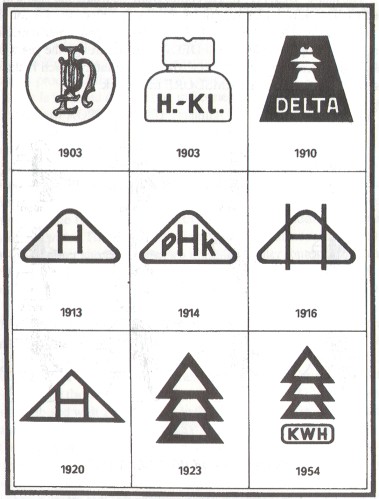
Development of the trademark
After World War II, when the Socialistic movement began to take hold in East
Germany, the member companies of HERMSDORF were designated as VEB'S, a
term indicating that they were "works owned by the people". These VEB'S,
were then put together into a so called KOMBINAT or "combine".
Today this KOMBINAT has several insulator manufacturing plants in various locations in what has been known
until now as East Germany. These are:
VEB KERAMISCHE WERKE HERMSDORF (insulators, lightning arresters,
bushings etc.)
VEB ELEKTROKERAMISCHE WERKE SONNEBERG (insulators, pflug gaps, bushings ro 36
KV etc.)
VEB ELEKTROPORZELLANWERK "MARGARETHENHUTTE" GROSSDUBRAU
(insulators, housings) Note: H.SCHOMBURG & SONS was bought out by this
company.
VEB PORZELLANWERK KLOSTER-VEILSDORF (low voltage insulators, ceramic parts,
etc.)
In the near future, KERAMISCEIE WERKE HERMSDORF will no longer be known as a
KOMBINAT but will become a production corporation. This will be indicated by the
letters AG (for joint stock company) or GmbH (for limited liability company)
following the name. Each of its member companies will be a profit center.
In January, 1990, KERAMISCHE WERKE HERMSDORF celebrated its 100th birthday!
On the occasion of this anniversary, a special article appeared in the HERMSDORF
TECHNICAL JOURNAL entitled "Ninety Years of Successful Development under
the Symbol of 'Tri-Delta'". (Yon will recall that even though the HERMSDORF
factory itself was first established in 1890, the DELTA BELL was not developed
until 1897). This article was authored by DR. HARRI STREUBEL, MESSERS. H.
DRESSELS, F. KERBE and G. DASCH.
I recently had the opportunity to borrow a rare hardbound HERMSDORF catalog
dated 1905. It contains no fewer than 112 full size drawings of the pin and
non-pintype insulators that were being offered at their plant in Altenburg,
Saxony at that time. I have chosen a few interesting styles to show you, but
sadly, in the process of copying and reducing them to 1/4 size, they have come
out quite dark, even though the catalog originals are beautifully done. This
wonderful book is truly museum quality! Many thanks to CHRIS HEDGES (Kansas
City, MO) for sharing. I remind him on a regular basis that he is to call me
when/if he grows tired of it. The pencil rubbing of the HP trademark is taken
from the back cover of the book and varies slightly from the one shown for 1903
in the chart.
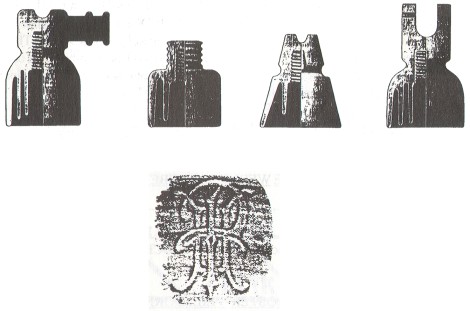
Selections from HERMSDORF'S 1905 catalog (above) with a
pencil rubbing taken
of trademark on back cover (below)
During its record long years of insulator production, HERMSDORF offered many
styles and sizes of insulators, which were not only used locally, but shipped to
far comers of the world. Shown below are a few typical styles you may see in
collections or at shows. Now, at least, you will be able to recognize and date a
HERMSDORF trademark when you see one! HERMSDORF is considered by some to be the
birthplace of porcelain insulators in Europe.
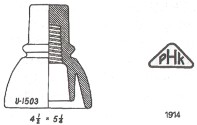 |
Found on telegraph lines in Australia
|
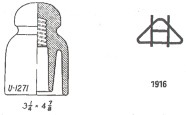 |
Used to supply power for ski lift in the Swiss Alps
|
 |
This one stayed close to home on a house in Germany
|
 |
U-2079 comes from Bogota, Colombia. New find!
|
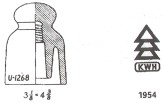 |
Ordered by OTE of Greece for use on its telephone lines
|
My sincere thanks to DR. HARRI STREUBEL (of HERMSDORF'S Department of
Standardizations, Product Testing and Quality Control), who answered all my
questions and also sent me the article from the HERMSDORF TECHNICAL JOURNAL; to
ARNE STRINDEMARK, President of IFO ELECTRIC of Sweden, who willingly identified
HERMSDORF trademarks, and put me in touch with DR. HARRI STREUBEL in the first
place. (MR. STRINDEMARK has been in the insulator business for 27 years and has
served as President of EUROC, or European Federation of Electroceramic
Manufacturers); to MR. H. DRESSELS (of HERMSDORF'S Public Relations and
Historical Records Department) for the gift book entitled UNSER WERK, which
means "Our Factory"; and finally, to Carol McDougald, for wading
through all these long unfamiliar words so you could read them!
|
